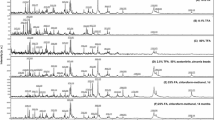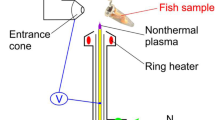Abstract
Foodborne intoxications caused by the consumption of fish and other products of marine origin contaminated with bacterial pathogens are an ever-present threat, either due to bacteria and/or its metabolites. In addition, the rapid spoilage of seafood due to microbial activity, results in high economic losses. The development of the microbiota in seafood products depends on the microbiological ambience of capture, processing and storage, and the applied preservation method. Thus, pathogenic and spoilage bacterial species in seafood may come from the indigenous microbiota of the aquatic ambience or are introduced by contamination during processing. Rapid and accurate bacterial species identification is essential for an effective control program to ensure safety and quality of either processed or minimally processed seafood. In the present work, matrix-assisted laser desorption ionization-time of flight mass spectrometry was successfully applied to identify 26 bacterial strains isolated from fresh fish and processed seafood samples. The approach was based on the comparison of unknown spectra to a reference spectral library and demonstrated to be a fast and accurate technique for bacterial species differentiation, which can be used for the rapid identification of foodborne pathogens and spoilage bacteria potentially present in products of marine origin.




Similar content being viewed by others
References
Al-Qadiri, H. M., Al-Alami, N. I., Al-Holy, M. A., & Rasco, B. A. (2008). Using fourier transform infrared (FT-IR) absorbance spectroscopy and multivariate analysis to study the effect of chlorine-induced bacterial injury in water. Journal of Agricultural and Food Chemistry, 56(19), 8992–8997.
Alm, R., Johansson, P., Hjerno, K., Emanuelsson, C., Ringnér, M., & Häkkinen, J. (2006). Detection and identification of protein isoforms using cluster analysis of MALDI-MS mass spectra. Journal of Proteome Research, 5(4), 785–792.
Ben-Gigirey, B., Baptista, V., de Sousa, J. M., Villa, T. G., & Barros-Velazquez, J. (2000). Characterization of biogenic amine-producing Stenotrophomonas maltophilia strains isolated from white muscle of fresh and frozen albacore tuna. International Journal of Food Microbiology, 57(1–2), 19–31.
Bernardo, K., Pakulat, N., Macht, M., Krut, O., Seifert, H., Fleer, S., et al. (2002). Identification and discrimination of Staphylococcus aureus strains using matrix-assisted laser desorption/ionization-time of flight mass spectrometry. Proteomics, 2(6), 747–753.
Böhme, K., Fernández-No, I. C., Barros-Velázquez, J., Gallardo, J. M., Calo-Mata, P., & Cañas, B. (2010). Species differentiation of seafood spoilage and pathogenic gram-negative bacteria by MALDI-TOF mass fingerprinting. Journal of Proteome Research, 9(6), 3169–3183.
Calo-Mata, P., Arlindo, S., Boehme, K., de Miguel, T., Pascoal, A., & Barros-Velazquez, J. (2008). Current applications and future trends of lactic acid bacteria and their bacteriocins for the biopreservation of aquatic food products. Food and Bioprocess Technology, 1(1), 43–63.
Campos, C. A., Rodríguez, Ó., Calo-Mata, P., Prado, M., & Barros-Velázquez, J. (2006). Preliminary characterization of bacteriocins from Lactococcus lactis, Enterococcus faecium and Enterococcus mundtii strains isolated from turbot (Psetta maxima). Food Research International, 39(3), 356–364.
Conway, G. C., Smole, S. C., Sarracino, D. A., Arbeit, R. D., & Leopold, P. E. (2001). Phyloproteomics: Species identification of Enterobacteriaceae using matrix-assisted laser desorption/ionization time-of-flight spectrometry. Journal of Molecular Microbiology and Biotechnology, 3(1), 103–112.
Daffonchio, D., Raddadi, N., Merabishvili, M., Cherif, A., Carmagnola, L., Brusetti, L., et al. (2006). Strategy for identification of Bacillus cereus and Bacillus thuringiensis strains closely related to Bacillus anthracis. Applied and Environmental Microbiology, 72(2), 1295–1301.
Dare, D. (2006). Rapid bacterial characterization and identification by MALDI-TOF mass spectrometry. In Y.-W. Tang & C. W. Stratton (Eds.), Advanced techniques in diagnostic microbiology (pp. 117–133). New York: Springer Science+Business Media.
Degand, N., Carbonnelle, E., Dauphin, B., Beretti, J.-L., Le Bourgeois, M., Sermet-Gaudelus, I., et al. (2008). Matrix-assisted laser desorption ionization-time of flight mass spectrometry for identification of nonfermenting gram-negative bacilli isolated from cystic fibrosis patients. Journal of Clinical Microbiology, 46(10), 3361–3367.
Donohue, M. J., Smallwood, A. W., Pfaller, S., Rodgers, M., & Shoemaker, J. A. (2006). The development of a matrix-assisted laser desorption/ionization mass spectrometry-based method for the protein fingerprinting and identification of Aeromonas species using whole cells. Journal of Microbiological Methods, 65(3), 380–389.
Eja, M., Abriba, C., Etok, C., Ikpeme, E., Arikpo, G., Enyi-Idoh, K., et al. (2008). Seasonal occurrence of vibrios in water and shellfish obtained from the Great Kwa River Estuary, Calabar, Nigeria. Bulletin of Environmental Contamination and Toxicology, 81(3), 245–248.
Elotmani, F., Assobhei, O., Revol Junelles, A. M., & Milliére, J. B. (2004). Microflora of fresh and ice-stored sardines (Sardina pilchardus) from the Maroccan Atlantic coast. Ciencias Marinas, 30(4), 627–635.
Erhard, M., Hipler, U.-C., Burmester, A., Brakhage, A. A., & Wöstemeyer, J. (2008). Identification of dermatophyte species causing onychomycosis and tinea pedis by MALDI-TOF mass spectrometry. Experimental Dermatology, 17(4), 356–361.
Feldhusen, F. (2000). The role of seafood in bacterial foodborne diseases. Microbes and Infection, 2(13), 1651–1660.
Feng, P. (2007). Rapid methods for the detection of foodborne pathogens: Current and next-generation technologies. In M. P. Doyle & L. R. Beuchat (Eds.), Food Microbiology: Fundamentals and Frontiers (3rd ed., pp. 911–934). Washington: ASM.
Fernández-No, I. C., Böhme, K., Gallardo, J. M., Barros-Velázquez, J., Cañas, B., & Calo-Mata, P. (2010). Differential characterization of biogenic amine-producing bacteria involved in food poisoning using MALDI-TOF mass fingerprinting. Electrophoresis, 31(6), 1116–1127.
Fonnesbech Vogel, B., Venkateswaran, K., Satomi, M., & Gram, L. (2005). Identification of Shewanella baltica as the most important H2S-producing species during iced storage of Danish Marine Fish. Applied and Environmental Microbiology, 71(11), 6689–6697.
Giebel, R., Worden, C., Rust, S. M., Kleinheinz, G. T., Robbins, M., Sandrin, T. R., et al. (2010). Microbial fingerprinting using matrix-assisted laser desorption ionization time-of-flight mass spectrometry (MALDI-TOF MS): Applications and challenges, Advances in Applied Microbiology, pp 149–184. New York: Academic.
Gram, L. (1992). Evaluation of the bacteriological quality of seafood. International Journal of Food Microbiology, 16(1), 25–39.
Gram, L., & Dalgaard, P. (2002). Fish spoilage bacteria—Problems and solutions. Current Opinion in Biotechnology, 13(3), 262–266.
Gram, L., & Huss, H. H. (1996). Microbiological spoilage of fish and fish products. International Journal of Food Microbiology, 33(1), 121–137.
Gram, L., Ravn, L., Rasch, M., Bruhn, J. B., Christensen, A. B., & Givskov, M. (2002). Food spoilage—Interactions between food spoilage bacteria. International Journal of Food Microbiology, 78(1–2), 79–97.
Hsieh, S.-Y., Tseng, C.-L., Lee, Y.-S., Kuo, A.-J., Sun, C.-F., Lin, Y.-H., et al. (2008). Highly efficient classification and identification of human pathogenic bacteria by MALDI-TOF MS. Molecular & Cellular Proteomics, 7(2), 448–456.
Huss, H. H. (1995). Quality and quality changes in fresh fish. Food & Agriculture Organization of the United Nations (FAO).
Huss, H. H., Reilly, A., & Ben Embarek, P. K. (2000). Prevention and control of hazards in seafood. Food Control, 11(2), 149–156.
Iwamoto, M., Ayers, T., Mahon, B. E., & Swerdlow, D. L. (2010). Epidemiology of seafood-associated infections in the United States. Clinical Microbiology and Infection, 23(2), 399–411.
Jay, J. M., Loessner, M. J., & Golden, D. A. (2005). Processed meats and seafoods (ed), Modern Food Microbiology. 7th ed, pp 101–124. Springer Science+Business Media, Inc., New York.
Keys, C. J., Dare, D. J., Sutton, H., Wells, G., Lunt, M., McKenna, T., et al. (2004). Compilation of a MALDI-TOF mass spectral database for the rapid screening and characterisation of bacteria implicated in human infectious diseases. Infection, Genetics and Evolution, 4(3), 221–242.
Kim, S.-H., Barros-Velázquez, J., Ben-Gigirey, B., Eun, J.-B., Jun, S.-H., Wei, C.-I., et al. (2003). Identification of the main bacteria contributing to histamin formation in seafood to ensure product safety. Food Science and Biotechnology, 12(4), 451–460.
Klaenhammer, T. R., Pfeiler, E., & Duong, T. (2007). Genomics and proteomics of foodborne microorganisms. In M. P. Doyle & L. R. Beuchat (Eds.), Food microbiology: Fundamentals and frontiers (3rd ed., pp. 935–951). Washington: ASM.
Kuhm, A. E., Suter, D., Felleisen, R., & Rau, J. (2009). Identification of Yersinia enterocolitica at the species and subspecies levels by Fourier Transform Infrared Spectroscopy. Applied and Environmental Microbiology, 75(18), 5809–5813.
Lay, J. O., Jr. (2001). MALDI-TOF mass spectrometry of bacteria. Mass Spectrometry Reviews, 20(4), 172–194.
Lehane, L., & Olley, J. (2000). Histamine fish poisoning revisited. International Journal of Food Microbiology, 58(1–2), 1–37.
Lhafi, S. K., & Kühne, M. (2007). Occurrence of Vibrio spp. in blue mussels (Mytilus edulis) from the German Wadden Sea. International Journal of Food Microbiology, 116(2), 297–300.
Mazzeo, M. F., Sorrentino, A., Gaita, M., Cacace, G., Di Stasio, M., Facchiano, A., et al. (2006). Matrix-assisted laser desorption ionization-time of flight mass spectrometry for the discrimination of food-borne microorganisms. Applied and Environmental Microbiology, 72(2), 1180–1189.
McCabe, K. M., Zhang, Y.-H., Huang, B.-L., Wagar, E. A., & McCabe, E. R. B. (1999). Bacterial species identification after DNA amplification with a universal primer pair. Molecular Genetics and Metabolism, 66(3), 205–211.
Mohania, D., Nagpal, R., Kumar, M., Bhardwaj, A., Yadav, M., Jain, S., et al. (2008). Molecular approaches for identification and characterization of lactic acid bacteria. Journal of Digestive Diseases, 9(4), 190–198.
Nassif, X. (2009). Editorial commentary: A revolution in the identification of pathogens in clinical laboratories. Clinical Infectious Diseases, 49(4), 552–553.
Neethirajan, S., & Jayas, D. (2010). Nanotechnology for the food and bioprocessing Industries. Food and Bioprocess Technology. doi:10.1007/s11947-010-0328-2.
Niven, C. F. J., Jeffrey, M. B., & Corlett, D. A. J. (1981). Differential plating medium for quantitative detection of histamine-producing bacteria. Applied and Environmental Microbiology, 41(1), 321–322.
Paludan-Müller, C., Dalgaard, P., Huss, H. H., & Gram, L. (1998). Evaluation of the role of Carnobacterium piscicola in spoilage of vacuum- and modified-atmosphere-packed cold-smoked salmon stored at 5 °C. International Journal of Food Microbiology, 39(3), 155–166.
Rodriguez, O., Barros-Velazquez, J., Ojea, A., Pineiro, C., & Aubourg, S. P. (2003). Evaluation of sensory and microbiological changes and identification of proteolytic bacteria during the iced storage of farmed turbot (Psetta maxima). Journal of Food Science, 68(9), 2764–2771.
Russell, S. C. (2009). Microorganism characterization by single particle mass spectrometry. Mass Spectrometry Reviews, 28(2), 376–387.
Seng, P., Drancourt, M., Gouriet, F., La Scola, B., Fournier, P.-E., Rolain Jean, M., et al. (2009). Ongoing revolution in bacteriology: Routine identification of bacteria by matrix-assisted laser desorption ionization time-of-flight mass spectrometry. Clinical Infectious Diseases, 49(4), 543–551.
Siegrist, T. J., Anderson, P. D., Huen, W. H., Kleinheinz, G. T., McDermott, C. M., & Sandrin, T. R. (2007). Discrimination and characterization of environmental strains of Escherichia coli by matrix-assisted laser desorption/ionization time-of-flight mass spectrometry (MALDI-TOF-MS). Journal of Microbiological Methods, 68(3), 554–562.
Teramoto, K., Sato, H., Sun, L., Torimura, M., Tao, H., Yoshikawa, H., et al. (2007). Phylogenetic classification of Pseudomonas putida strains by MALDI-MS using ribosomal subunit proteins as biomarkers. Analytical Chemistry, 79(22), 8712–8719.
Tsai, Y.-H., Kung, H.-F., Chen, H.-C., Chang, S.-C., Hsu, H.-H., & Wei, C.-I. (2007). Determination of histamine and histamine-forming bacteria in dried milkfish (Chanos chanos) implicated in a food-borne poisoning. Food Chemistry, 105(3), 1289–1296.
van Baar, B. L. M. (2000). Characterisation of bacteria by matrix-assisted laser desorption/ionisation and electrospray mass spectrometry. FEMS Microbiology Reviews, 24, 193–219.
Vargha, M., Takáts, Z., Konopka, A., & Nakatsu, C. H. (2006). Optimization of MALDI-TOF MS for strain level differentiation of Arthrobacter isolates. Journal of Microbiological Methods, 66(3), 399–409.
Ward, D. R. (2001). Chapter I: Description of the situation. Journal of Food Science Supplement, 6(7), 1067–1071.
Acknowledgments
The authors thank Dr. Francisco Barros (Unidad de Medicina Molecular, Fundación Pública Galega de Medicina Xenómica, Santiago de Compostela) for his excellent technical assistance with 16S rRNA sequencing. This work was funded by the PGIDIT Research Program (Project PGIDIT06PXIB261164PR) of the Xunta de Galicia (Galician Council for Industry Commerce and Innovation). The work of K. Bohme and I.C. Fernandez-No is supported by a “Maria Barbeito” and “Lucas Labrada” research contract from Xunta de Galicia.
Author information
Authors and Affiliations
Corresponding author
Rights and permissions
About this article
Cite this article
Böhme, K., Fernández-No, I.C., Gallardo, J.M. et al. Safety Assessment of Fresh and Processed Seafood Products by MALDI-TOF Mass Fingerprinting. Food Bioprocess Technol 4, 907–918 (2011). https://doi.org/10.1007/s11947-010-0441-2
Received:
Accepted:
Published:
Issue Date:
DOI: https://doi.org/10.1007/s11947-010-0441-2




